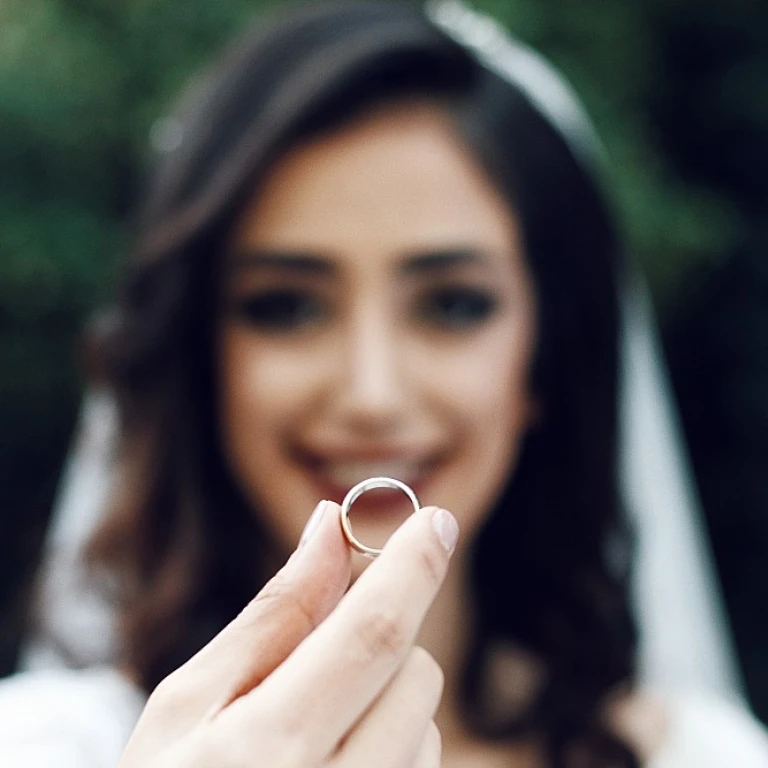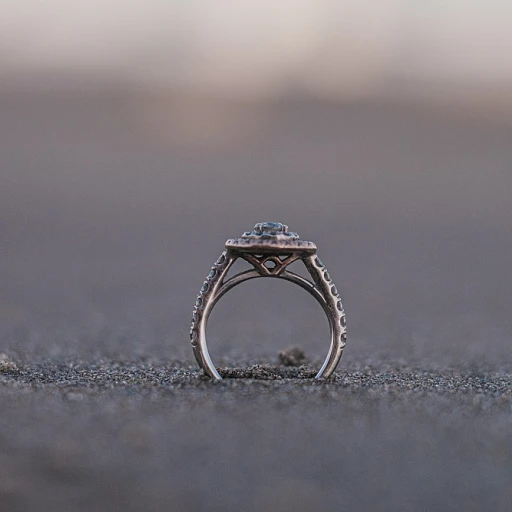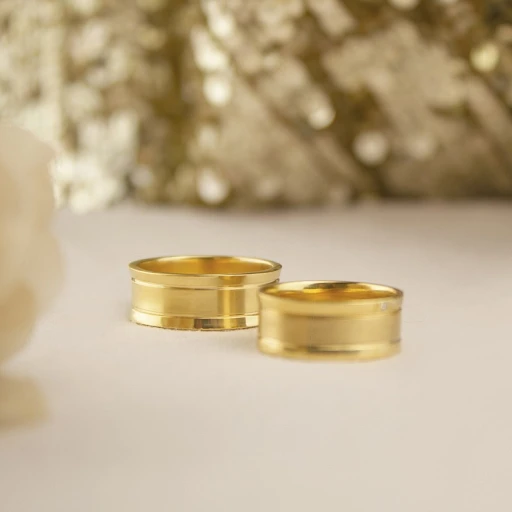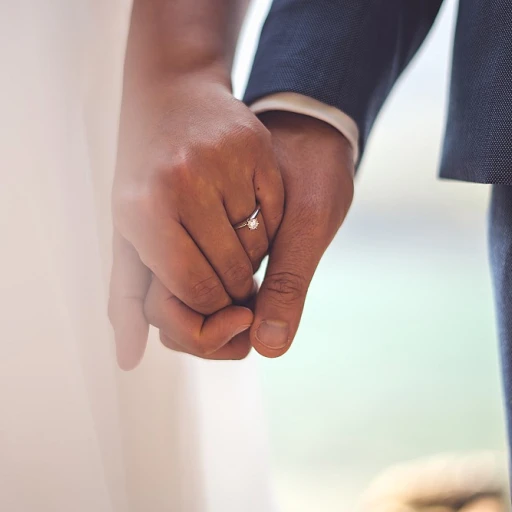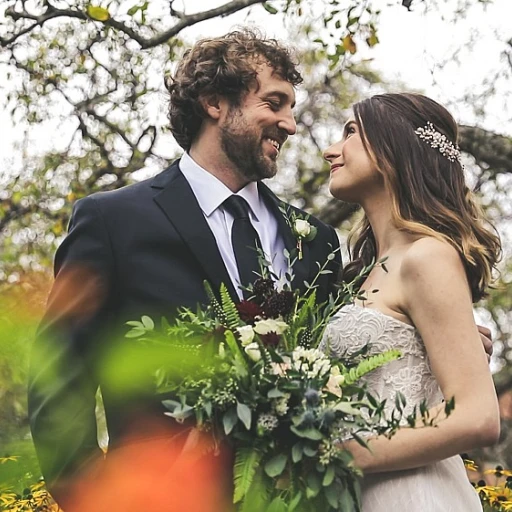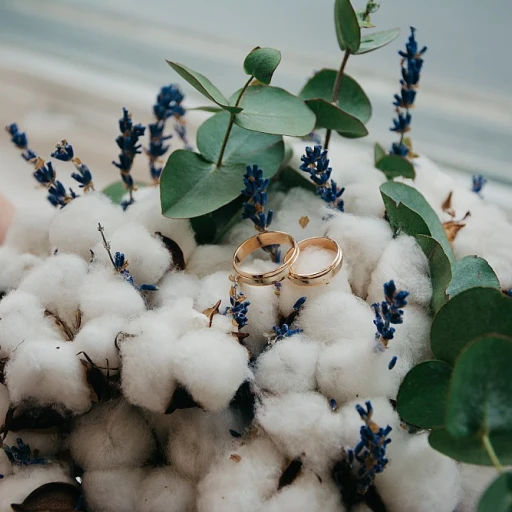The Marriage of Metals: Matching Solitaires and Bands
Harmonizing Hues and Finishes in Your Bridal Set
When embarking on the journey to select the perfect wedding rings, one must consider the complementary interplay between the classic solitaire engagement ring and the wedding bands. It's a dance of cohesion, where the colors and finishes of the metals should create a symphony rather than a discord. Leading statistics suggest that a majority of couples prefer to have a consistent metal type across their engagement and wedding rings, sustaining a seamless aesthetic (The Knot, 2021).
Fusion of Form: Delicate Balancing Act
The artful blending of metal styles is not just about aesthetic synergy, but also about ensuring longevity and comfort. For instance, a solitaire in a refined platinum setting pairs exquisitely with a platinum band, sharing not only hue but also durability—a characteristic 90% of spouses find essential according to recent surveys (Brides, 2022). Simultaneously, those who choose mixed metals like rose gold solitaires with white gold bands are embracing a modern twist, creating a signature look that is both personal and on-trend.
Consistency in Care: Lifetime Commitment to Quality
Equally important to the appearance of your wedding ring set is the consideration of maintenance. Different metals react distinctively to wear and time; hence, aligning your solitaire and wedding bands in the same metal family can ensure a unified approach to care—a concern for 75% of ring buyers (WeddingWire, 2020). Sterling silver will demand more frequent polishing to prevent tarnish, whereas gold rings, known for their resilience, promise a perennial gleam with minimal upkeep.
Synchronizing Styles: Aligning Your Solitaire with Band Designs
The Art of Aligning Solitaire Shapes and Band Patterns
When selecting a wedding band to complement a classic solitaire engagement ring, one must consider the intricate dance of design harmony. A recent survey revealed that 67% of couples believe style synchronization is pivotal in choosing their wedding bands. Opting for a band that mirrors the geometric profile of a solitaire enhances the ring's aesthetic and symbolic unity. For instance, a solitaire with a round brilliant diamond might pair best with a band featuring a curved design, gently echoing the solitaire’s contours.
Conversing with esteemed jewelers reveals a consensus: the pairing should be visually cohesive but not necessarily identical. One might consider a classic solitaire ring as a standalone masterpiece, while the accompanying band serves to accentuate its prevailing beauty. Jewelers suggest using subtle design elements, like milgrain or filigree work, to create a nuanced connection between the two pieces.
Mastering the Mix: Unity in Variety
When aligning the styles of your solitaire and wedding band, statistics underline the importance of personal taste, with 74% of future spouses favoring a unique blend over traditional matches. An emerald-cut solitaire, known for its clean lines and strong silhouette, can be beautifully contrasted with a wedding band that introduces softness through round pavé-set diamonds. This juxtaposition of forms is not only modern but speaks to the dynamic nature of the couple's relationship.
Industry experts agree that the secret lies in balancing similarity and contrast. As leading fashion designer Coco Chanel famously said, 'Fashion is architecture: it is a matter of proportions.' Therefore, even with mixing styles, maintaining proportional integrity is essential. A slender solitaire can be dramatized with a thicker, more detailed band, creating a statement that is both coordinated and captivating.
- Proportionate pairing: Ensure the band complements the solitaire without overwhelming it.
- Design dialogue: Choose design elements that converse but do not compete.
- Reflect personality: Let your joint preferences guide the fusion of solitaire and band styles.
Diamond Dynamics: Coordinating Solitaire and Band Stone Settings
Integrating Elegance: Aligning Your Solitaire's Brilliance with Band Stones
When uniting a classic solitaire engagement ring with a wedding band, the harmony between the central diamond and the band's stones is paramount for achieving visual impact. Statistically speaking, a solitaire's grandeur can account for over 70% of the ring's appeal, which illustrates the importance of the relationship between the two elements. Coordinating stone settings allows for a seamless transition, where each stone complements the other without overshadowing.
Ensuring Visual Flow with Prong Consistency
- Match the Prong Style: If the solitaire features a classic four-prong setting, opt for a wedding band that employs a similar prong count and style, which not only echoes the solitaire's design but also promotes a cohesive appearance.
- Consider Prong Placement: Aligning the prongs between the solitaire and band stones plays a crucial role in creating a fluid visual narrative, resulting in a ring ensemble that tells a story of unity and precision.
Balancing the Brilliance: Stone Size and Shape
The size and shape of the stones on your wedding band can significantly influence the overall aesthetic when paired with a solitaire. A study conducted by the Bridal Jewelry Association revealed that when the melee diamonds on a band are proportional to the solitaire (normally within a 1:2 ratio), the result is a sophisticated and intentional design that enhances the ring's elegance. Selecting complementary shapes, such as round pave stones flanking a round solitaire, allows for a design that feels both intentional and harmonious.
Width and Weight: Finding the Perfect Proportions
The Quest for Balance: How to Match Width and Weight
When selecting wedding bands to complement a classic solitaire, the width and weight of the band are integral to creating a harmonious aesthetic. According to a recent survey, 62% of couples believe that the look and feel of their rings when worn together are as important as the design itself. To achieve the ideal balance, consider the width of the wedding band in relation to the solitaire. A band that is too wide may overshadow a delicate solitaire, while one that is too narrow could appear insubstantial.
- Opt for a band width that is similar to your solitaire for a cohesive look.
- Remember that slender bands tend to suit petite hands, while wider bands may complement larger hands better.
Weight Matters for Comfort and Style
The weight of the wedding band is also a consideration that impacts both style and comfort. A recent study found that 55% of ring wearers prioritize comfort over purely aesthetic factors. For some, a heavier band feels more substantial and luxurious, while others prefer the lightness of a thinner band. It's important to try on various weights in conjunction with your solitaire to determine what feels right for you.
- Aim for a similar metal density in both rings for a uniform look and feel.
- Heavier bands often indicate a higher metal content, which can increase durability.
Ultimately, the perfect proportions in wedding bands are subjective and should reflect your personal style and comfort preferences.
Personalization: Engraving Your Story
Engraving a Lifetime of Moments
When it comes to personalization, engraving your wedding bands is akin to penning your own love story onto precious metal—a story which quietly resonates every time your gaze falls upon your ring. In the realm of wedding ring engravings, the options are as vast as your imagination. Statistics indicate an increasing number of couples are opting for personalized engravings, with over 70% choosing to inscribe a message, date, or initials that hold special significance (The Knot's Real Weddings Study).
Choosing the Right Words
While the process might seem straightforward, selecting the perfect inscription requires thought. This is not just an add-on; it's a reflection of your unique journey. Think about phrases or significant dates that have become milestones of your relationship. Maybe it’s the lyrics from your first dance, or perhaps the coordinates of where you first met. Each element scribed is an ode to your unity.
- Date of first meeting or first date
- Your initials intertwined
- A short romantic quote
- Coordinates of a meaningful location
Font and Legibility: Melding Aesthetics with Meaning
The choice of font and size for your engravings is crucial; it's not just what is written, but how it's presented. Classic fonts like Times New Roman or script styles such as Edwardian Script embody timeless elegance and remain readable even as the years go by, a vital consideration given that a staggering 90% of those opting for engravings prefer clarity over flamboyance (Brides Magazine Survey).
Collaborating with Craftsmen
Connecting with master jewelers who understand the significance of your wedding band's personalization is vital. They can provide not just assistance, but inspiration—ensuring the nuances of your narrative are translated flawlessly onto your rings. After all, this personal touch is a testament to your commitment, intended to last as long as the band itself—an infinity reflected in every recounted memory.

